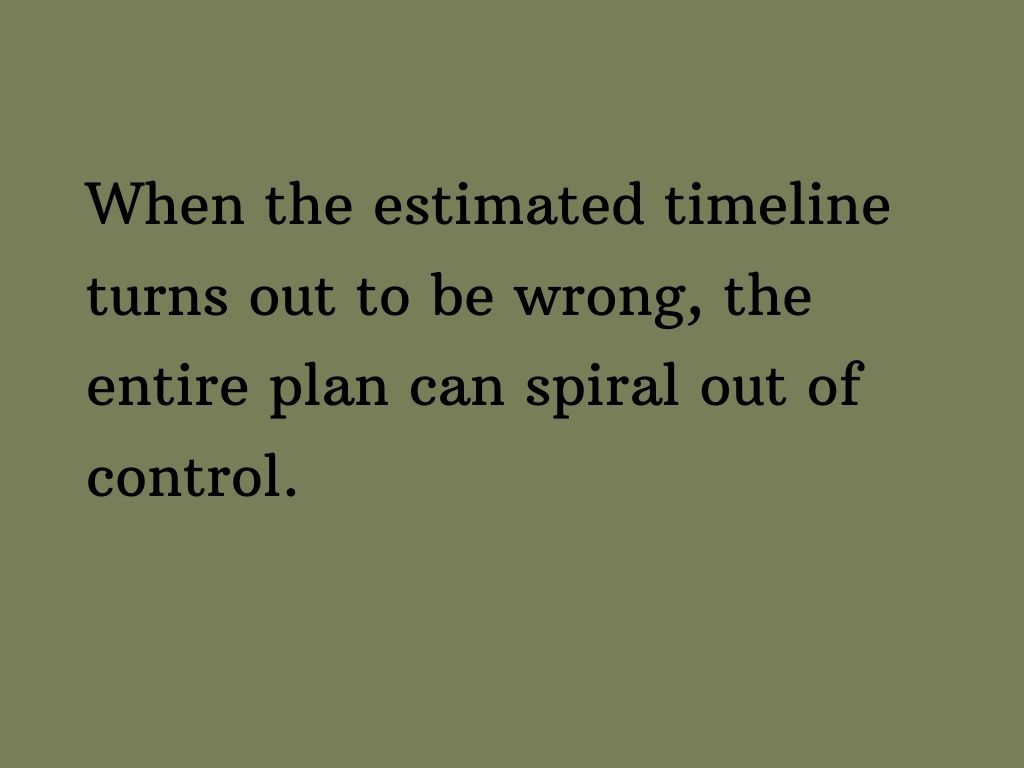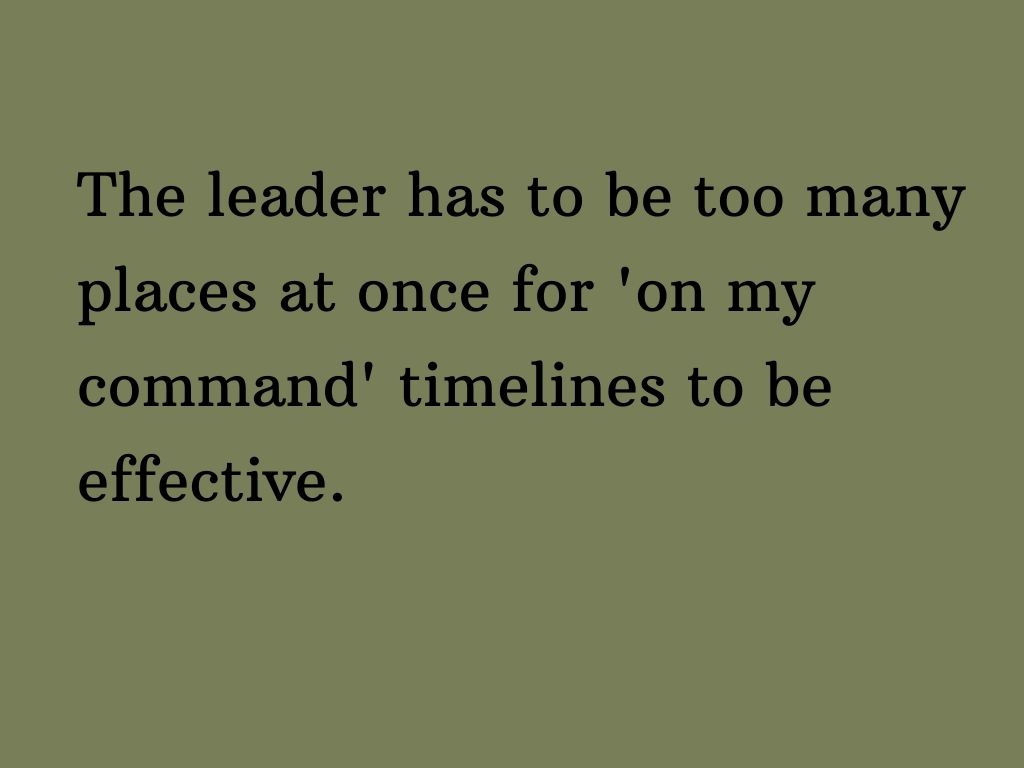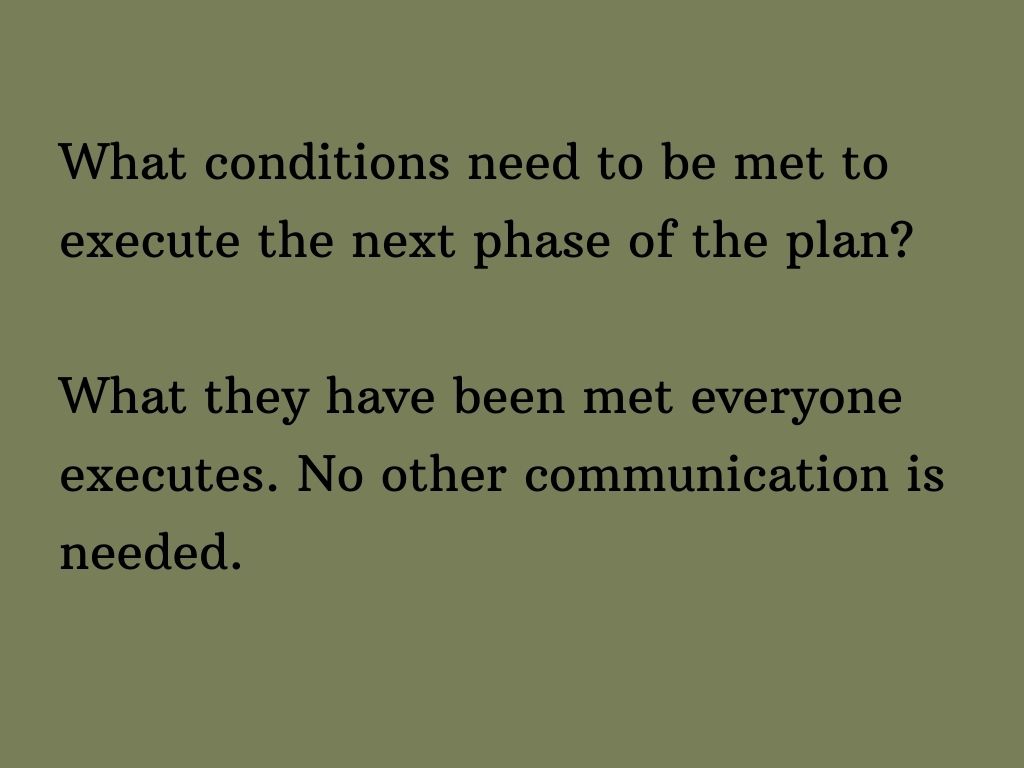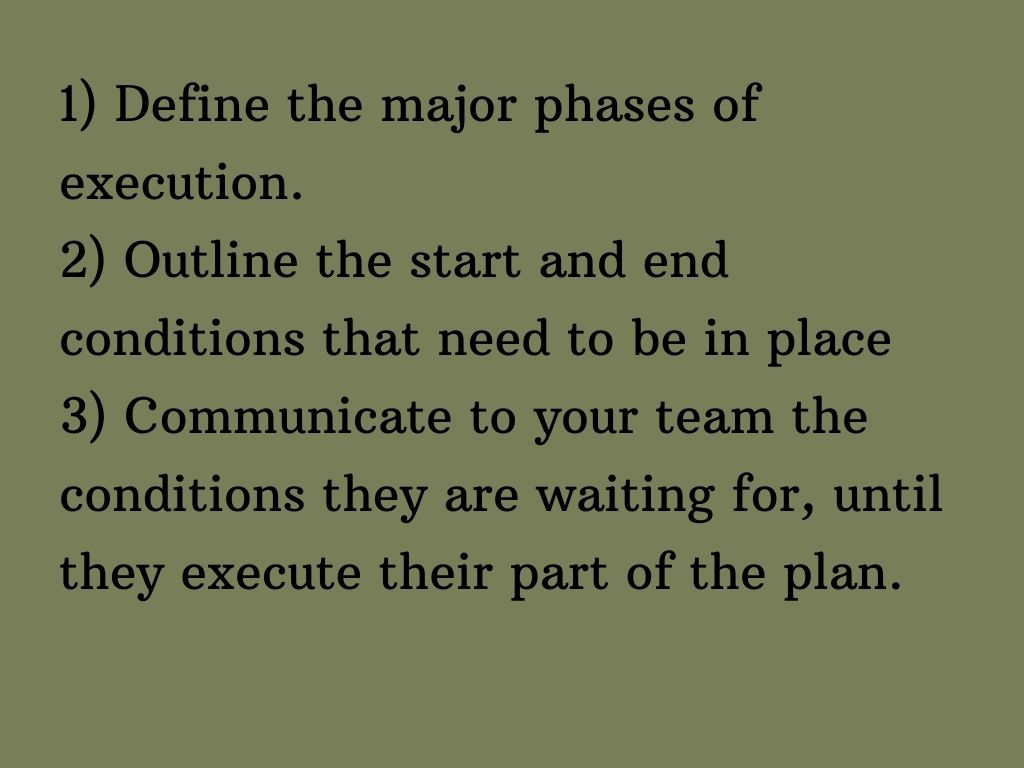Summary
-
The infantry uses ‘conditions set’ timelines to execute complex attacks and maneuvers.
-
Instead of time-based, or on command, the condition set specifies certain criteria that need to be met before the next phase starts.
-
This allows the subordinate leaders to use their judgment to start executing.
WAR
Imagine you are commanding thousands of Marines in a loud, stressful, and complex battle. In order to win, you need large groups of infantry to perfectly sequence their movement. If one group gets too far ahead or behind, they put everyone at risk.
What is the best way to coordinate large groups of people?
This is a problem that faces all levels of leaders in both the military and civilian world. In war, bad timing gets people killed. In the civilian world, bad timing can cause entire projects to fail.
The military solves this problem with ‘conditions’ driving timelines. This replaces ‘at this time’ or ‘on my command’.
‘At this time’ and ‘on my command’ timelines
A few common options to help coordinate are to set a time to start or to have a leader instruct everyone when they should start. Both options add major risks to the success of a timeline.
Using time to coordinate is as simple as it gets. The leader sets specific times when each group should start.
A few simple examples:
- First Squad will attack at 0800.
- Second Squad will attack at 0830.
In the example above, the First Squad could take 45 minutes to execute their attack, making them 15 minutes late. That 15 minutes could have a major impact on the Second Squad, causing chaos if they attack at 0830.

It is extremely challenging to predict how long something will take. There are thousands of variables that impact when work gets done. If you aggregate all of those into a large project, you are going to have a high risk of incorrectly predicting the timeline.
A second option is on my command.
This is where a leader will directly signal their team to start executing. This could be by talking to them, using a radio, sending a message, throwing smoke, waving flags, or sending an email. The list could go on forever. It is anything that sends a direct message from a leader to the other leader to execute.
A few examples of on my command:
- I (the leader) will be located with the First Squad. They will attack, when I tell them to attack (on my command).
- The Second Squad will also attack when I tell them (on my command). This will be via radio or voice (yelling), since I will not be located with them at that point.
The problem is that leaders communicate less effectively than they expect. The message will often not be clear, on time, or will not be received at all. This causes the subordinate leaders to not execute, while they wait for the command.

On my command timelines leave the leader as the single point of failure. It drastically reduces initiative.
This makes relying on it to drive timelines very risky.
Conditions set timeline
The final option, which is discussed in this article, is using a conditions set timeline.
A simple definition of conditions set is to outline what criteria need to be met, to allow the next phase to start successfully.
An example of the conditions needed to drive a car:
- Condition 1 – Open the door and sit in the driver’s seat.
- Condition 2 – Start the car.
- Condition 3 – Push the brake.
- Condition 4 – Put the car in drive.
Once those four things have happened, all conditions have been met to drive.
A simple war example:
- First Squad will attack Hill 22
- Condition 1 – First Squad is set in an assault position near Hill 22.
- Condition 2 – First Squad sees effective suppression of the enemy on Hill 22 from mortars.
- Once those two things have happened, conditions are set for the First Squad to attack.
- Second Squad will attack Hill 33
- Condition 1 – Second Squad is set in an assault position near Hill 33.
- Condition 2 – Second Squad sees that First Squad has secured Hill 22.
- Condition 3 – Mortars have shifted from Hill 22 to Hill 33 and are effectively suppressing the enemy.
- Once those three conditions have been met, Second Squad can attack.
These timelines are based on conditions. The conditions are things that need to be in place to execute. They rely on observation and initiative from the lower leaders. Anyone who is informed of the conditions will know when to execute. This helps to keep everyone on the team engaged.

In the example above, Second Squad can monitor Hill 22 to see if First Squad has secured it. Once they have it secured, Second Squad will start to prepare for the mortars to shift to Hill 33, which will set the conditions for them to attack. No radio calls or signals are needed.
The biggest benefit to condition set timelines is that the subordinate leaders can take more initiative. When they see that the predetermined conditions have been met, they are cleared to start. Their judgment can determine when to execute. This empowers them to make decisions and speeds up decision-making across the organization.
The hard part of condition set timelines is that they take much more upfront work. It’s very simple to tell your team a time or to go when you tell them. It’s much harder to define and communicate all the conditions that need to be met for them to execute.
It will take time and back-and-forth communication between the teams to confirm that everyone understands the conditions. The lower leaders will then need to pass that down to their teams, so more people are informed. There may be situations where you don’t have that much time to communicate. If you train your team to be good at identifying conditions, you can speed up that process. However, conditions set timelines will usually take more upfront work.
Time, command, and conditions
Best practice would have time, command and conditions timelines all incorporated together. They are not mutually exclusive. Conditions are a concept that is not widely used, so I wanted to write it that way. In many cases, however, time and command are incorporated into the conditions.
Well-defined and communicated conditions will ideally be driving the timeline.
The specific applications in the business world are discussed below.
BUSINESS
Every company is trying to hit a timeline. In most cases, this timeline requires work from multiple people or teams. The teams have to deliver work in the correct sequence or the timeline will get delayed.
Most teams use time to coordinate. Everyone needs timelines from other teams, so they know when things will get done. They want those timelines because they need to know when the conditions will be set for them to execute their part of the plan.
A much more effective way to track is to set the conditions and update on the progress against them.
How to plan conditions into your timeline
At a high level, there are three steps to using conditions set:
- Define the major phases of execution.
- Outline the start and end conditions that need to be in place
- Communicate to your team the conditions they are waiting for, until they execute their part of the plan.
To define the major phases of a plan, think about the three to five pieces of work that need to happen.
To launch a denim jean line:
- Design the jeans
- Build a prototype
- Secure financing
- Manufacture the first run of jeans
Next, figure out the conditions that must be in place for the next step to be executed.
Some helpful questions assist in figuring out what conditions need to be done to execute:
- What needs to happen for everything to be in place for this part of the plan to start?
- What will it look like, when this part of the plan ends?
- What are the ideal conditions for them to successfully execute?
- What are un-ideal but still tenable conditions that would allow them to still likely be successful?
These questions will help you add the start and end conditions for each phase of your plan.

To build a denim jean line:
- Design the jeans
- Start – Outline the demographic and vision for the product
- End – A specific design is produced that allows a manufacturer to build a prototype
- Build a prototype
- Start – The plans are sent to the manufacturer and a quote is agreed to
- End – Prototypes are sent back and agreed to be complete
- Secure financing
- Start – Prototypes are presented to investors
- End – Funds are sent to the business bank account
- Manufacture first run of jeans
- Start – Initial product run is agreed to
- End – Initial product run is in the business warehouse ready to ship
Thinking in terms of the start and end of a phase of the plan is very helpful to focus on what conditions need to be in place at a high level.
Once you understand the start and end, the team has two jobs:
- Update everyone on the status of when those conditions will be met and the next phase will start. This allows the next team to prepare to begin their phase.
- Divert all necessary resources to expedite the work and remove obstacles.
Communicating to everyone the status of this phase of work, is where time and direct communication will start to be helpful. When it is clear that the next phase of work is almost ready, the leaders should communicate to the next team to prepare them to start.
Once you understand what it will take to start the next phase of the plan, you should focus everything possible on setting that condition. If this condition gets delayed, the entire project is delayed.
In summary, make sure that everyone understands the conditions to move to the next phase of work and do everything to keep that moving and to prepare the next team.
Soft and hard timelines
There are two types of timelines: soft and hard timelines. Soft timelines are mostly under your control and you can release them when ready. However, the preference is usually earlier than later. Hard timelines are happening, whether you are ready or not.
Soft timelines
The anxiety is usually driven by an arbitrary timeline that was created at the beginning of the project. However, the timeline ultimately didn’t really matter. The only thing that matters, is if the conditions are in place to move to the next phase of work.
Executing with a conditional timeline will be a major mindset shift.
These are my general recommendations:
- Set a very vague overall timeline and use the high end of that timeline to create room
- Plan the project at a high level with a focus on large conditions that need to happen to enable the phases of work to start
- Communicate the overall sequence of events, so everyone is aware of what they are waiting on
- Devote all available resources to complete the current conditions (this is called massing and will be covered in another article)
Time and on my command still have a place within the conditions. Your communication should be double or triple layered, so nothing gets missed. Set the conditions, tell the people the conditions are set, email them to confirm the conditions have been set and then throw a party to celebrate the conditions being met.
Hard timelines
In this case, the timeline is happening whether you are ready or not.
Let’s say you are preparing a Black Friday marketing campaign for a retail store. If you aren’t ready it’s not going to go well. You can’t push the timeline out for Black Friday, since the middle-aged moms are coming no matter what.
Conditions still apply. The condition is either completed in time or not completed in time. You’re either going to pay up front by getting the work done or pay in the back end by lost business.
The general recommendations still apply with some tweaks:
- Set a hard timeline with a clear end state for that date. This step is much more important. It has to be crystal clear to everyone, what everything should look like by that date.
- Plan the project at a high level with a focus on key conditions that need to happen to enable the phases of work to start. It is recommended to have as much detail as possible in this step. If you’re going to hit your hard timeline, the work needs to be understood
- Communicate the overall sequence of events, so everyone is aware of what they are waiting on. Dependencies will cause idle time and will kill your timeline.
- Devote all available resources to completing the current conditions (this is called massing and will be covered in another article). In this step, you must be completely ruthless in the execution of the conditions. In war, men would literally be dying in the sacrifice of setting that condition. Dependencies need to be cleared to move to the next condition
When you have a hard timeline, planning and preparation are critical and sacrifices will need to be made. If all conditions need to be met by the timeline, there will likely need to be sacrifices made by other teams.
Conclusion
The key to hitting any timeline is figuring out how to set conditions to move to the next phase of work. The better those conditions are understood by everyone, the more likely they are to get done. The more time on task you have working on each condition the faster you’ll finish your project.
Resources:
- None

0 Comments